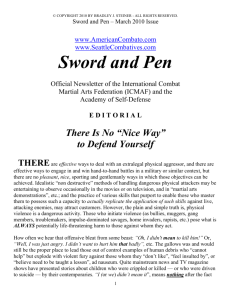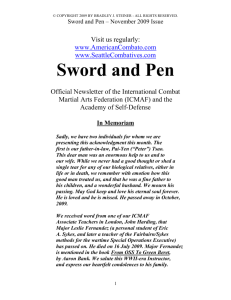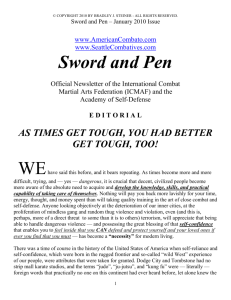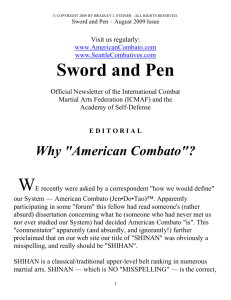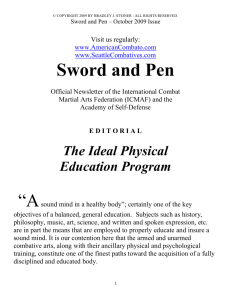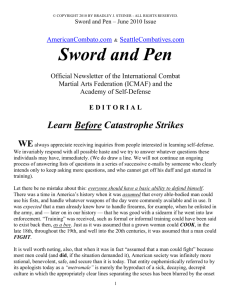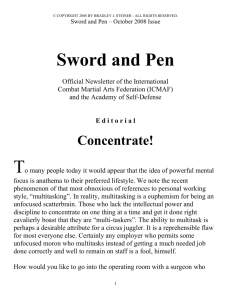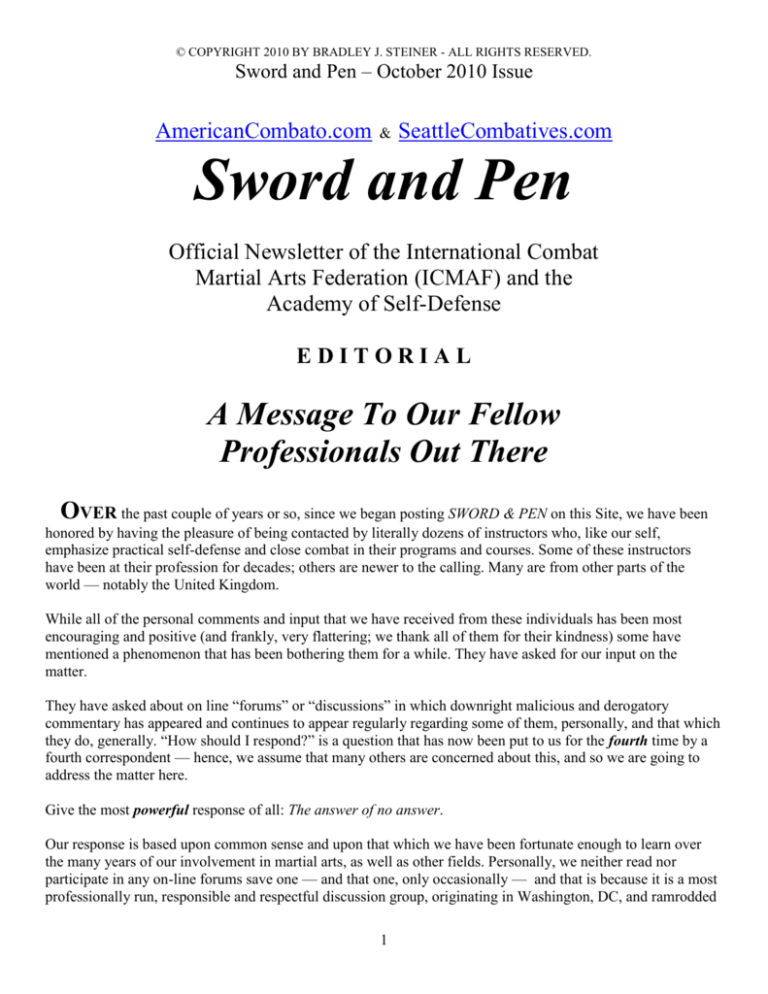
© COPYRIGHT 2010 BY BRADLEY J. STEINER - ALL RIGHTS RESERVED.
Sword and Pen – October 2010 Issue
AmericanCombato.com
&
SeattleCombatives.com
Sword and Pen
Official Newsletter of the International Combat
Martial Arts Federation (ICMAF) and the
Academy of Self-Defense
EDITORIAL
A Message To Our Fellow
Professionals Out There
OVER the past couple of years or so, since we began posting SWORD & PEN on this Site, we have been
honored by having the pleasure of being contacted by literally dozens of instructors who, like our self,
emphasize practical self-defense and close combat in their programs and courses. Some of these instructors
have been at their profession for decades; others are newer to the calling. Many are from other parts of the
world — notably the United Kingdom.
While all of the personal comments and input that we have received from these individuals has been most
encouraging and positive (and frankly, very flattering; we thank all of them for their kindness) some have
mentioned a phenomenon that has been bothering them for a while. They have asked for our input on the
matter.
They have asked about on line ―forums‖ or ―discussions‖ in which downright malicious and derogatory
commentary has appeared and continues to appear regularly regarding some of them, personally, and that which
they do, generally. ―How should I respond?‖ is a question that has now been put to us for the fourth time by a
fourth correspondent — hence, we assume that many others are concerned about this, and so we are going to
address the matter here.
Give the most powerful response of all: The answer of no answer.
Our response is based upon common sense and upon that which we have been fortunate enough to learn over
the many years of our involvement in martial arts, as well as other fields. Personally, we neither read nor
participate in any on-line forums save one — and that one, only occasionally — and that is because it is a most
professionally run, responsible and respectful discussion group, originating in Washington, DC, and ramrodded
1
© COPYRIGHT 2010 BY BRADLEY J. STEINER - ALL RIGHTS RESERVED.
Sword and Pen – October 2010 Issue
by a friend who operates a first class gymnasium there. He will not tolerate neurotic, hen-like gossip and
mudslinging, and so we have no problem being involved occasionally with answering his visitors‘ questions, on
line.
We recommend not responding to or participating in the nonsense orchestrated by those groups that our
correspondents have mentioned in their inquiries to us, at all. Just teach. Do right by your students and continue
to study, train, develop, and give the best efforts of which you are capable to the work that you love, and leave
the toxic human waste alone. And make no mistake about it: Rational people will readily identify and condemn
the malicious mudslingers as the toxic human waste that they are. No response from you is needed! As far as
the irrational and malevolent little snipes are concerned, there is no way to prevent them from feeling or saying
whatever they please — and there is no reason to care about them.
People who have little to occupy their lives with that is of any serious importance or meaning love to criticize,
attack, denigrate, and strive to create discord and dissension. However, if you reply to these creatures they then
get credibility; because you are silly enough to recognize them!
Many in this field, as is the case in just about all other fields, resent and are envious of the success, good name,
reputation, and quality-of-product that their superiors purvey. When one cannot objectively point to flaws in the
product and in the philosophy behind it, one slings mud. One spits out attacks hoping to make the fools who
believe the venom accept that those whom the malcontents recognize to be their superiors in every way are —
―teaching ineffective skills‖, ―are afraid to fight in challenge events‖, are ―violating tradition‖, are ―dishonest‖,
are ―not teaching true martial arts‖, are ―egotistical‖, are . . . you-name-it.
Notice that we have never had any ―commentary‖ section in either this or in our other site
(www.seattlecombatives.com). The reason is because we do not want our sites to be cluttered with
meaningless, interminably pointless and useless babble from individuals of the kind we are now discussing. We
respect our quality — i.e. our fully human — visitors too much to subject them to that; and we personally have
no patience for it, ourself. We want to push the best instruction, the most reliable advice, and the most helpful
information — every single month. We always and without exception respond personally and courteously to
those who write to us individually with respect and intelligent sincerity, but we dismiss and relegate
immediately to the trash heap any and all disrespectful or what is in our judgment inane, communications.
Thankfully, we have, over the years, received almost none of these!
Our purpose is communicating the truth — the best — in practical close combat and self-defense information
and advice that can be written. And we know that there are others out there endeavoring to do the same.
That — and teaching — is what we are about. We urge those instructors with whom we have been in touch to
take the same attitude and to follow the same path that we have found to be most rewarding and beneficial.
Backyard gossip, the creation of dissent, sneering lies and innuendo, discord, infantile attempts at mockery or
whatever, are and should remain the province of those despicable, neurotic malcontents and sociopaths who
revel, and who belong, in such garbage.
Years ago we listened to a marvelous speech by the late Arthur Jones. Jones is the inventor of the justifiably
famous Nautilus Machines. Jones was making a point about those who maliciously fabricate and criticize, and
who count upon the ignorance and gullibility of those who are dumb enough to pay attention to them, in order
to have an audience for their nonsense.
2
© COPYRIGHT 2010 BY BRADLEY J. STEINER - ALL RIGHTS RESERVED.
Sword and Pen – October 2010 Issue
―Those who are for real, those who are productively occupied, those who know what they are doing and who
have established a rock-solid, well-known and respected reputation, have no time to waste replying to whatever
sea of fools is ‗out there‘, who choose to believe whatever lies may be told about them,‖ he said. (I am of course
paraphrasing Jones). ―Those who are lied about and who are attacked have not the time or interest to reply.
Those stupid enough to simply believe whatever they are told or whatever they may read, pay the price by
missing out on the truth.‖ Then he gave a marvelous example:
There was a multimillion-dollar business that started up, and that made its fortune and its reputation by claiming
that it was offering a dietary plan that had been developed and was attributable originally to an extremely
prestigious English University. They openly and enthusiastically used the name of this University in promoting
their diet. The diet had never been developed at this University. The University had no connection with those
who were promoting the product by using the University’s name; and in fact the University hadn’t the
slightest knowledge whatever of who the purveyor of this “diet plan” was, or even of what the diet consisted!
The owners of the diet business and the purveyors of this “dietary plan” were unlawfully violating the rights
of the University by using — without permission — the name of the University in their enterprise.
“Now why didn‟t —— University initiate a lawsuit against these charlatans?” Jones asked rhetorically. “Very
simply, they could not be bothered. They would not spend the money, waste the time, or invest the necessary
energy. Their assumption was that anyone dumb enough to believe that which these crooks were saying, was
going to have to bear the consequences of being duped. The University had its task of educating its students, to
attend to, and that is where it focused its efforts.”
YOU shouldn‘t bother with those who sputter about how your methods, your system, your schools, your focus
on practical defense work, your character. etc. etc. etc. is lacking. Let „em yap! As those who study with you see
for themselves the immense value of that which we in this field strive so mightily to do, and as they become
familiar with the philosophy and doctrine that we espouse (through your web sites, and through ours, too), the
scum will be washed away and regarded with the contempt that they fully deserve.
Once again, we wish to express our deepest thanks and appreciation to those professional teachers who, in
addition to countless dedicated students of close combat, visit and follow our sites every month.
Keep training hard! We will always do our best to assist you.
Bradley J. Steiner
3
© COPYRIGHT 2010 BY BRADLEY J. STEINER - ALL RIGHTS RESERVED.
Sword and Pen – October 2010 Issue
You Don’t Need To Be An Expert
SUCH documentation as does exist regarding the successful defense of self, others, home, and hearth by the
intended victims of violent criminal bacteria is most encouraging. Obviously, it is inspiring. It is GOOD to hear
or to read in the news that a private citizen thwarted a dangerous attacker — and we shall be honest: It makes us
feel real good if he thwarted them in a manner that left those violent perpetrators permanently out of action.
But there is more to be had from the studying of reports of successful self-defense than the feeling of inner
satisfaction and justice that these stories engender. There is a lot to be LEARNED. Yes, one can learn a great
deal from all reports of all violent crime; whether the bacteria or the victim prevailed in the outcome, but if you
wish to know ―what it takes to be successful in defending yourself‖ you simply cannot do better than to take a
long hard look at those stories describing the people who DID it, and detailing, in many instances, HOW they
did it.
We have been studying this since the 1960‘s. We have not only read countless news stories and police reports,
we have also spoken with those who had defended themselves successfully. In many instances these ―success
stories‖ did involve the intended victim‘s recourse to martial arts skills. But in many more than that, the
successes had nothing at all to do with any formal martial arts or self-defense training, per se. The following is
that which we have found to be the most important factors responsible for victims‘ successes in protecting
themselves against violent, dangerous physical attack:
1. The victim fought back.
With or without ―skill‖ THIS proved to be the most important factor responsible for successful selfdefense. Fighting back. In some instances the victims fought back with techniques of defense that they had
acquired during formal training under qualified experts; in the majority of instances the victims simply fought
back in whatever physical manner they were able. It was not the debilitating injuries that the intended
victims were able to inflict upon the scum who attacked them that accounted for the success of the
defensive effort. It was the mere fact that the victims did not accept being violated. They physically resisted
— quite often, awkwardly. But their resistance caught the vermin off guard, and enabled the victims to prevail.
2. The victim got very angry.
RAGE manifested the moment the individual who had been successful in defending himself realized
that he (or she) was being targeted by a violent offender. In some instances the rage was downright murderous
— and there was little other than this furious mental state that prompted the intended victim in his response to
the event.
3. The victim attacked.
We know of no instance when a ―purely defensive‖ approach to handling a violent attack has ever been
successful. In fact, we have heard of instances when persons who ―only tried to cover up‖ or to ―get away‖
prompted increased fury in the assailants.
4. The intended victim had no concerns about either being injured or with injuring his assailant.
Clearly, a person under attack who fights back does not wish to be injured. That is not the point. The
point is that those people who successfully defended themselves have done so by abandoning concern over
4
© COPYRIGHT 2010 BY BRADLEY J. STEINER - ALL RIGHTS RESERVED.
Sword and Pen – October 2010 Issue
being injured — for the time being. They also were not hesitant about hurting their attacker. Neither
humanitarian nor legal concerns arose in the successful defender‘s mind to block his all-out retaliatory efforts.
5. There was no ―squaring off‖ and ―fighting‖ per se. The intended victim simply exploded when the attacker(s)
moved against him.
Being effective in defending himself was not attributable, in the case of the private citizen who did so, to
being a “better fighter” than his assailant. (Whether the victim was in fact a better fighter or not appears to have
invariably been a moot point). In a real emergency “fighting skill” per se, in the conventional, competitive
sense that the term is generally employed in today‟s context in the field of martial arts, did not seem to matter.
Pretty straightforward stuff, eh? And the bottom line — lesson-wise — from this analysis of actual situations
from which completely normal people had extricated themselves is: YOU NEED NOT BE AN “EXPERT” IN
A MARTIAL ART IN ORDER TO DEFEND YOURSELF SUCCESSFULLY.
Now we must emphasize that being a genuine expert in a good COMBAT system is certainly an asset. Only a
fool would deny that. However, the important point is that expertise in a formalized system of unarmed (or even
armed) combat does NOT rate as the ―top‖ or as the ―key‖ requirement for effectively handling a difficult or
dangerous situation on the street or anywhere else. Simply FIGHTING BACK OFFENSIVELY AND
WITHOUT ANY WARNING WHILE FUELED WITH RAGE, AND NOT CONCERNING ONESELF
WITH EITHER ONE’S OWN INJURIES AT THE MOMENT, OR WITH HOW BADLY ONE INJURIES
ONE’S ATTACKER, appears to be the key element to success. Add to that expertise in, say, the physical
techniques of American Combato or another quality system of close combat, and your chances of successfully
stopping whoever intends to harm you or yours are excellent, if not nearly-certain.
Keep constantly in mind that relatively simple, basic physical skills are all that is required — technique-wise —
in order to prevail in a close combat defense emergency. Thus, do not believe that ―only after you‘ve trained for
many years‖, or ―not until you‘ve qualified for brown or for black belt‖ can you feel certain that you ―have the
skill‖ that you‘ll need to defend yourself. If you are getting that particular sense — or if it has been formally
stated to you — then you are probably training in a classical/traditional martial art, and not in a practical
method. Even in a classical/traditional method, it will not do to merely have acquired performance capabilities
in order to employ your techniques for real. Remember that! You will need that which we have summarized in
the preceding paragraph; and if your goal is self-defense and being able to handle a close combat situation, you
might as well train in a system that will give you that which you want in one tenth or less the time that a
classical/traditional method might give it to you — technically speaking.
We have had great success in teaching persons of statistically average strength and agility to adequately handle
the majority of violent unarmed confrontational predicaments involving single attackers that typically occur,
after a period of three months‘ or less serious training. There are no miracles and there is no magic. However,
with practical, reliable, war-proven skills in which a reasonably intelligent and disciplined person is willing to
train properly for several months, a sometimes surprisingly effective capability in self-defense can often be
developed.
This much we can assure anyone: You do not need to become an expert in order to become well able to defend
yourself.
5
© COPYRIGHT 2010 BY BRADLEY J. STEINER - ALL RIGHTS RESERVED.
Sword and Pen – October 2010 Issue
Training Intensity
NEARLY half a century of participation in weight training, and even longer than that participating in martial
arts has made us realize certain truths about how to train that we always like to pass on, for the benefit of others.
One critical thing to understand by all who follow serious training as a lifetime pursuit is that — once you‘ve
built up or/ and fully developed your skill proficiency maximum — the best possible physical condition and
physical ability with skills is maintained when training intensity is varied, according to strength and energy
levels that ebb and flow at the various times when training is scheduled to be taken.
Development of the human body (strength, muscle size and shape, agility, internal fitness, health) does not and
cannot continue to progressively increase forever. If we assume that proper training is undertaken, and that a
sensible all-round progressive method of developing — via weights — is employed, then a person commencing
his workouts in his late teens, in his 20‘s, or 30‘s, should achieve his genetic potential within two to three years
of consistent training. As far as reaching a peak in combative abilities it is a little more difficult to estimate time
length, since in this case there is the question of developing good tactics and mindset, no less than finding —
over time — the skills that suit one, ideally, as an individual. However, we can certainly state with confidence
that everyone eventually reaches his own personal peak if he trains regularly and hard, and that that ―peak‖ will
inevitably vary between individuals — just as a peak in strength and muscular development will vary. Everyone
is a unique individual. We are all born with unique potential — and with definite limitations.
But let us address the question of how one ought to train once one has “developed” — developed physically (in
strength, condition, and muscle) and developed technically (i.e. in combatives expertise).
The wisest course in ongoing, lifetime training, is to workout with rigorous consistency (the health benefits are
beyond belief!) but with varying intensity. Striving to go all out at every training session — attractive as the
idea may seem, when discussed — will inevitably lead to staleness and to failure. The right way to train is not to
attempt to push yourself at every session (of either physical training or combat arts work), but instead pace
yourself. If you workout very hard and heavy with the weights but one day each week, that is plenty. In fact, a
really hard workout once every two weeks may be more than enough for many individuals. The remaining
workouts that you take should vary between light and medium-heavy, no more. Our own personal training
schedule is to workout three times each week — one light, one medium, and one heavy workout. That works
well for us. Experiment a bit, if you‘re in the maintenance stage of physical training, and see what works best
for you. The key is to allow your body to ease up in its efforts as well as push hard, so that optimum strength is
maintained along with general fitness and condition, and the body avoids going stale or becoming exhausted.
Combatives work (―martial arts‖) should be followed in a similar manner. Hard, tough workouts with the blows,
combinations, counterattacks, and natural weapons conditioning are great — and necessary — but they must
not be overdone. Especially if you are over 40 or 50. Two really tough, full-blast sessions of training each week
is more than sufficient, with another two or three undertaken at reduced effort-output — say somewhere
between 50% and 65% of your capacity. These less intense practice sessions are not a waste of time, by any
means. Just like the more moderate weight training workouts, they give your body an opportunity to enjoy the
health benefits of exercise without overdoing it. They keep your hand in, enable you to review effectively, and
they assist you in maintaining enthusiasm for the harder, tougher practice sessions.
6
© COPYRIGHT 2010 BY BRADLEY J. STEINER - ALL RIGHTS RESERVED.
Sword and Pen – October 2010 Issue
If you adhere to a schedule of one all-out weight training session every week to two weeks, and one really
tough, all-out combat arts practice session once every week, while following workouts of reduced and
varying intensity levels on your other training days, you will be able to maintain the finest and highest level of
both physical condition and combative proficiency possible — according to your genetic potential.
Question: “Isn‟t it important to have a day of complete rest — no exercise or practice at all — once a week?”
Our opinion is that the human body should be vigorously but not excessively exercised every single day. One
needs ―a day of rest‖ only when one has really battered oneself with tough training. However, that rest may
often best be taken by LIGHT to MODERATE training and exercise, not by complete inactivity.
There are two exceptions to the ―every day‖ exercising rule: 1. If you are ill, then rest completely. You need
your full recuperative powers when you are not well, and any training at such a time merely depletes your vital
reserves and, in our opinion, is extremely unwise. 2. If you find that you‘ve ―overdone it‖ and are now stale
and at a training standstill where the mere thought of training makes you want to lie down and go to sleep!
Don‟t ignore staleness. If you do occasionally overdo it (and we all do — occasionally) then REST. But absent
either of those two conditions, we believe very strongly that the human body benefits and thrives from daily
vigorous exercise. Just make sure that it‘s not excessive, and that you vary your workout intensities and practice
sessions so that you accommodate your body‘s need for change, rest, and recuperation and recovery between
tough workouts.
We have always found that daily workouts and regular combat arts practice sessions “make our day”. We can
forego all sorts of daily nonsense and social crap . . . BUT DO NOT INTERFERE WITH OUR TRAINING!
We know that there are visitors to our sites who live, feel, and train the same way that we do — or at least with
the same love for their training that we have. We hope that these comments have assisted those visitors in
planning for a continued lifetime of ongoing, rewarding workout and practice sessions.
Developing The Fingertips Thrust
SOME of the best things in life are simple! In the field of self-defense one of the best basic techniques is a
straightened fingertips thrust to an attacker‘s eyes. This excellent technique may be employed any time that you
have a hand free and an adversary moving in on you.
We laugh when we recall our days in ju-jutsu. It wasn‘t all bad, but damn! — We spent countless hours going
over counters to wrist holds, arm holds, jacket grabs, collar grabs, and shoulder holds or hair grabs of every
conceivable variety. We trained in fine motor skills that, in retrospect, were obviously absurdly impractical. If
only we had been taught the simple fingertips thrust to the eyes, THAT would have solved virtually every one
of those “situations” for which we wasted hour upon hour learning wrist locks, arm locks, and elaborate
(undoable) throws.
This technique is simplicity itself. Open your hand and extend your fingers, holding them together loosely. Do
not tense your hand or stiffen your fingers. Just extend your arm in a snapping forward thrust (being careful not
to draw the hand back first, or make any other telegraphing movement) and drive your extended four fingers
powerfully through your attacker‘s eyes. Note: Of course you won‘t be able to actually ram your fingers
7
© COPYRIGHT 2010 BY BRADLEY J. STEINER - ALL RIGHTS RESERVED.
Sword and Pen – October 2010 Issue
through your opponent‘s eyes; but the idea is when you thrust you must aim to go through the eyes, which will
give you the power you need to inflict at least sufficient injury to disorient your enemy for a few seconds.
Breaking his leg with a side kick, kicking him in the testicles, or driving a powerful uppercut punch into his
solar plexus are all excellent followups to an eye thrust.
While having strong fingers is always an asset, and hand strength is not to be dismissed as being unimportant in
close combat technique applications, you really do not need powerful fingers in order to make this simple action
work for you. Surprise, speed, and accuracy above all, are what is crucial. Everyone‟s eyes are delicate and
sensitive to attack.
Surprise is developed by applying good tactics, deception, and common sense; and by training so that you never
telegraph your move. Speed comes from high repetition practice and by continually striving to move faster and
still faster. Relax before striking and then whip the thrust straight out like a striking snake! Accuracy may be
developed through the use of an inexpensive training aid: a ―Lone Ranger‖ mask.
These little masks can be purchased in party supply shops. Hang one by placing a string at each end and
suspending it from any convenient support. Doorways work very well. It should be at approximately your own
face level for most of your practice.
Practice doing 20, 30, 40, and eventually 50 or more full force, speedy thrusts with each hand in a practice
session directly into the ―eye openings‖ of the mask. After two or three weeks of daily practice you should have
the accuracy of a striking king cobra! Always stand a natural distance from the mask and treat it as though it
was the face of an opponent.
Another excellent, though considerably more costly, training aid is a BOB or BOBXL training dummy. The
face and body of the dummy makes practice a bit more realistic. Do not tense your fingers.
The fingertips thrust to the eyes should be one of the key strikes taught to all who are interested ―only in basic
self-defense‖, and who — at least for the time being — are not interested in pursuing the study of close combat
and self-defense as a full-term martial art. Once well mastered, this simple, effective technique can be counted
upon to deter just about any punk, tough, lout, bully, troublemaker, or other scummy form of living mistake
whom society lacked the foresight to put to death before the damn creature could walk.
“But Aren’t Guns Dangerous?”
IT is our policy to always recommend to all female students whom we accept for training that they become
familiar with and rely primarily upon a good firearm for defense against rape, kidnap, home invasion, and
similar deadly forms of attack.
Occasionally, a female student will follow our advice. The combined learning of hand-to-hand physical defense
techniques, the acquisition of proper combat mindset and personal security tactics, and the possession of a good
firearm along with the skill and knowledge of how to use it lawfully and well, offers the woman who will work
to acquire it, not only a solid means of RELIABLE and REALISTIC protection, but peace of mind and a
sense of self-confidence and justifiable security, as well.
8
© COPYRIGHT 2010 BY BRADLEY J. STEINER - ALL RIGHTS RESERVED.
Sword and Pen – October 2010 Issue
The phenomenon of dangerous physical violence and terroristic intimidation that some males (by no means
“all”, despite the hallucinatory lunacy belched out by the psycho feminist malcontents) directed against women
is the epitome of ugliness and evil. That a legitimately adjudicated conviction of forcible rape does not carry the
death penalty is one of many reasons why decent people may on occasion tend to spit at the criminal ―justice‖
system (and you know perfectly well why justice has been placed in quotations!).
Perhaps one out of ten females pays attention to what we say and proceeds to factor firearms into her selfdefense planning and preparations. Most of them usually respond when they hear us advise them of the benefits
of being properly armed and educated in the lawful and moral use of guns, by asking something like: “But
aren‟t guns dangerous? Wouldn‟t having a gun be asking for trouble — almost encouraging violence? And
wouldn‟t it be easy for a criminal to take the gun away and shoot me with it?”
In only the rarest of exceptional instances do we bother to answer such questions. They simply grate on our
patience too severely, and we prefer not to reply to an individual, rather than reply with an edge and a tone of
contempt in our voice.
We have decided that right now, here in Sword & Pen, we will answer these common ―responses‖ to out urgent
admonition to responsible ladies — and men — that they be armed. It will be in print. It can be read. Men can
read it to their own women, if they wish. No edge in our voice to betray any negative feelings, and — as we
write this — we‘re feeling good after a hard workout at our striking post, so there‘s not the slightest hint of
contempt in that which we present.
Yes. Guns are dangerous. They are very dangerous. Therein lies their immense value. If they were not
dangerous they would be as valueless as t‟ai ch‟i exercise or aikido are, insofar as serious self-defense is
concerned.
Having a gun is no more ―asking for trouble‖ than is having a fire extinguisher “asking” for a fire to break out.
Guns are tools. They have no will of their own. They simply provide an enormous and deadly enhancement of a
human being‘s ability to strike blows in close combat emergencies, when such is necessary to protect against
dangerous, potentially deadly threats. Far from “encouraging violence” a powerful sidearm in the hand of a
woman (or anyone) who is competent to use it, and who is fully prepared to use it, if necessary, is about the
greatest DISCOURAGER of violence imaginable. It is the apparent helplessness of any victim (male or female)
that “encourages violence”. Solid defensive preparation results in deterrence, if it results in anything. (Were
the kind of human filth who attacked women constantly concerned about being shot dead when they made their
approach, there is no doubt that these disgusting attacks on women would drastically diminish in number — if
not be eradicated entirely.)
It certainly might be easy for a criminal to take your gun away from you and use it on you — IF YOU LET
HIM. (In fact, as we once pointed out during a seminar we gave at the University of Washington when a young
lady asked us about this very thing: The only instances of a person’s own weapon having been taken away
and then subsequently used against him by the criminal offender have been — tragically — instances of law
enforcement officers being disarmed of their own handguns.) But this need not happen to the private citizen
who is under no obligation to assume the awful risks that our courageous uniformed protectors so often must
take. If you learn how to employ your firearm properly, train so that you will do so in a crisis, and possess the
requisite level of mental preparedness that good training will help you instill, the only thing that any violent
criminal will be able to “take away” from you will be the bullets that you fire into him!
9
© COPYRIGHT 2010 BY BRADLEY J. STEINER - ALL RIGHTS RESERVED.
Sword and Pen – October 2010 Issue
Relation Between Technical And
Physical Training
HARD training in close combat and self-defense skills provides a lot of extremely beneficial exercise.
However, one does not (or certainly should not) approach combatives work for exercise, per se. Train in
combatives for combat and self-defense, pure and simple. Let the ancillary exercising benefit be a plus that you
accept as ―coming with the territory‖.
Exercise in addition to your combatives training is all but essential. It is essential if you aspire to maximum
development of your combatives potential; the technical practice alone will not get you to your personal peak.
Look at the example long established by every elite military unit in the world. Soldiers who are trained as
Rangers, Special Forces troopers, etc., and sailors who train to be Navy SEALs, receive hundreds of hours of
technical skills work with all sorts of weapons, survival techniques, and war gear. However, no matter how
rigorously these men train in physically demanding skills and activities, they always follow a rugged physical
training program in addition to everything else that they do.
Perhaps a short-term student of self-defense who is ―only looking for the basics‖ can obtain that which he is
seeking simply by learning and practicing a set of combat skills. But all of us who are in this for life, and for
whom combatives is a complete martial art will want to follow a rigorous, consistent physical training regimen,
in addition to our technical practice.
The finest physical training is weight training — weight training done sensibly and progressively either with
adjustable barbells and dumbells (―free‖ weights), with Nautilus machines, with pulleys, with rubber or spring
cables (―chest expanders‖), or even with improvised weights. But the body can be brought to a peak of strength
and condition only when subjected to demands that compel the muscles to increase in strength, and the organs
and bone structure to manage overload. Such exercising cannot continue progressively forever, since after two
or three years of correct training a person will reach his genetic maximum. However, maintenance of the peak
achieved is highly desirable, and this is easily done by continuing to workout sensibly with weights once one
has built up to his genetic limits.
Weight training will do wonderful things for your technical ability. You will of course be stronger. However, if
you train correctly, you will become much more agile, faster, better coordinated, and tougher. Your body will
become better able to ―take it‖, too; weight training builds resilience.
Weight training also provides great mental benefits. Confidence always increases when you can feel yourself
growing stronger, and actually see the increased strength in the increasing amount of solid iron and steel that
you can lift. You know that you are stronger than most people (and if you train regularly and correctly, you will
be stronger than most people, since most people do not follow a regular weight training program) and this
enhances your confidence in being capable of fighting back well, if any situation requires that you do so.
The only caution that we wish to leave our readers with is not to confuse the roles of technical and physical
training. They beautifully complement each other — but neither one replaces the other.
10
© COPYRIGHT 2010 BY BRADLEY J. STEINER - ALL RIGHTS RESERVED.
Sword and Pen – October 2010 Issue
If you train hard in low front and side kicks (the two key kicking techniques of serious unarmed combat) you
will develop excellent, reliable kicks. If you augment this practice by working out on heavy barbell squats two
or three times a week, you will greatly bolster your kicking formidability. However, merely squatting will never
replace the need for technical practice of the kicks (just as no amount of kicking practice can ever produce the
sheer power in your hips and legs that squats will produce). The two activities (technical practice of skills and
hard progressive resistance exercise) are perfect complimentary activities. If you are after optimum
development and confidence, make both of them a regular part of your routine.
The exercises that typically precede a ju-jutsu or karate class are largely useless for serious combatives. Yes,
the limbering and stretching warm you up for the Class, and possibly assist you in improving your flexibility —
but that flexibility is not necessary for close combat, and it just may prove injuriously detrimental if you
continue it through your later years. We have known numerous individuals who, as black belt holders, had
acquired lifetime injuries through too much over-stretching. Unless you are genetically predisposed to be
extraordinarily flexible YOU ARE RUNNING THE RISK OF SERIOUS AND POSSIBLY PERMANENT
INJURIES DOING MANY OF THE “EXERCISES” THAT ARE PRACTICED IN
CLASSICAL/TRADITIONAL MARTIAL ARTS SCHOOLS.
The marvelous thing about properly performed weight training is that it develops you in a healthful, balanced,
complete way. When you are 90 you will still be able to train with weights. And if — at 90 — you have been
training with weights for four to seven preceding decades, you will be stronger, fitter, and more healthy than
most men less than half your age! Look at Jack LaLanne. He‘s in his middle 90‘s, and he works out every day.
He is more agile and fit at 95 than many college students are, in their early 20‘s!
Weight training is the ticket to the strength, health, and fitness that you‘re after. It is a ―natural‖ adjunct to
combatives work, since it not only builds all round solid fitness, it produces raw strength more efficiently,
safely, and speedily than anything else can — and you need strength in close combat.
When, as a boy of sixteen, we began weight training, we had already been a student of martial arts in one form
or another for a long time. Yet, we were not genetically favored with either strength or athletic acumen. Within
two months of beginning a systematic weight training program we experienced a literal TRIPLING of our
ability in martial arts work. We experienced a boost in confidence that was almost uncanny. Our hitting ability
shot up so dramatically that we wondered if we were dreaming. And (in ju-jutsu) we began to experience an
ability to throw practice partners with an authority that we had not up until then been able to generate; and
several people with whom we trained even commented on this. ―What‘s happening,‖ one ju-jutsu partner asked
us. ―You‘re stronger, Brad!‖ Before our first month of weight training had elapsed we had already decided
that this was going to remain a lifetime activity and habit, just as our martial arts work would.
We hope we can turn you onto this path, if in fact you haven‘t started on it, already. Combine your practice
(regularly, consistently, effortfully) with a serious program of progressive resistance physical training . . . and
watch the results!
No, you will never be a superman unless your genetics has programmed you for such development. But you can
get super results — and attain the optimum level of development that your genetics permits. And NOTHING
CAN OR WILL HELP YOUR TECHNICAL AND MENTAL ABILITY IN CLOSE COMBAT AND SELFDEFENSE MORE THAN THAT!
11
© COPYRIGHT 2010 BY BRADLEY J. STEINER - ALL RIGHTS RESERVED.
Sword and Pen – October 2010 Issue
Get REAL In Your Training, Now!
REGARDLESS of what you may be studying or training in
at present — even if you are self-teaching, via books and
DVDs — you can benefit beyond measure by availing
yourself of the CD text materials we have prepared and are
offering for sale:
1. THE MOST EFFECTIVE BLOWS OF UNARMED
COMBAT — $13.
This concise Manual, which may be read on your
computer screen or printed out in a hard copy, describes the
16 most crucially important blows which comprise the
―basic blows‖ syllabus of American Combato (Jen•Do•Tao).
You‘ll learn what the blows are, how to execute them, which
targets to strike, and the best ways to perfect their
development as natural hand-to-hand battle weapons.
2. ATTACK COMBINATIONS — $15.
Here in one powerful Manual is described 30 of the most
reliable, effective, destructive combination sequences that
we teach in American Combato. The descriptions are easy to
understand, and anyone who really masters a half dozen of
these unique attack combinations will be a thoroughly
formidable person, indeed, in hand-to-hand combat!
12
© COPYRIGHT 2010 BY BRADLEY J. STEINER - ALL RIGHTS RESERVED.
Sword and Pen – October 2010 Issue
3. MENTAL CONDITIONING FOR CLOSE COMBAT
AND SELF-DEFENSE — $30.
A brand new 214 page self-instruction book that is
available nowhere else. It is copyrighted, but you may print
out a hard copy for your personal use — or read it on your
computer screen. This is the first book to actually teach a
comprehensive program of mental conditioning for the
combatives student or professional.
FREE with this book, on the same CD, is a copy of Jack
Grover‘s classic, DEFEND YOURSELF!, and Robert
Carlin‘s impossible-to-find gem, COMBAT JUDO. These
two books should be printed out n hard copies for serious
study.
4. RULES OF SELF-DEFENSE — $17.
Perhaps the most politically INcorrect presentation of
20 "rules" (ahem!) for winning in anything-goes close
combat and self-defense. Each rule is presented with
sufficient descriptive force so that you will definitely "GET
IT", and a few dramatic illustrations help to get the point
across.
13
© COPYRIGHT 2010 BY BRADLEY J. STEINER - ALL RIGHTS RESERVED.
Sword and Pen – October 2010 Issue
This Manual is for anyone practicing any martial art
who wishes to gear his training and his mental preparedness
for the REAL THING! Students in our Classes, and those
who take private lessons from us are pounded relentlessly
with these concepts; they will be a healthy reminder for
students of American Combato. However, for anyone
practicing ju-jutsu, karate, judo, boxing, etc. and who wants
to get ready for those "contests" played for KEEPS, this
Manual is a "must have" reference!
5. THREE MONOGRAPHS — $22.
Here are three monographs you will not want to miss:
1. The Myth of Groundgrappling, 2. An Annotated Copy of
Fairbairn‟s WWII Silent Killing Course, and 3. The Physical
and Psychological Factors required For Success In Handto-Hand Combat.
ALL OF THE ABOVE RECORDED IN THE HIGHEST
QUALITY SPEED, AND ON THE FINEST QUALITY
CD DISCS IN “PDF” FORMAT FOR YOUR
CONVENIENCE AND LIFETIME LEARNING.
Also available is the quality revised Paladin Press reprint of
our 1970‘s Classic that ―started it all‖ in this ―WWII
14
© COPYRIGHT 2010 BY BRADLEY J. STEINER - ALL RIGHTS RESERVED.
Sword and Pen – October 2010 Issue
methods/practical combat/offense based fighting, etc.‖
movement:
The Tactical Skills of Hand-to-Hand Combat — $14.
We will autograph your copy, and we will include a
document available from no other source, explaining the
significance and role of this little Classic in making the
martial arts seeking public aware of an entirely new and
more effective approach to personal combat than had
hitherto been taught or recognized, outside the military and
intelligence training circles of the Allied Forces, during the
second world war.
We pay first class postage on all purchases, except foreign
orders. Please include $3.00 per item, additional (U.S.
dollars) to cover air mail shipping overseas. Send your
orders, with cash or money order only payable to:
BRAD STEINER
P.O. BOX 15929
SEATTLE, WASHINGTON 98115
U.S.A.
15
© COPYRIGHT 2010 BY BRADLEY J. STEINER - ALL RIGHTS RESERVED.
Sword and Pen – October 2010 Issue
Appealing To The Deranged?
A psychologically healthy person has no desire to engage in gratuitous violence. A knowledgeable teacher of
close combat and self-defense knows enough about violence to emphasize its serious dangers, to stress the fact
that it is not related to sport, and to screen people to a reasonable extent, so that the nutjobs and other
troublesome types are not accepted for instruction by him. And a professional teacher of this subject will do
everything to encourage his students to avoid anything resembling violence if at all possible.
It is regrettable that some (by no means all) of those who are purporting to be training people in realistic close
combat skills and practical self-defense actually utilize slogans and catch phrases in their promotional
endeavors that draws undesirables to that which they are teaching! Suggesting, for example, that by learning
certain skills that are being offered one will become feared and ―enjoy‖ being able to knock others senseless if
they ―dare to bother you‖, etc., is not, in our opinion, being responsible.
Quality combatives, such as comprise what is taught in American Combato, are to be regarded with the same
attitude that a sane, responsible person regards a firearm which he keeps for personal protection: Never is the
weapon to be used unless the possessor believes himself or his loved ones to be in danger. And if the weapon
should be required, then its use should be total, unhesitant, aggressively decisive, and with the sole objective of
neutralizing a threat that could not otherwise have been stopped.
Training is certainly enjoyable and to be regarded as a highly desirable, beneficial, and healthful endeavor.
However, the use of that which one is training in must be relegated to the same place that a healthy nation
relegates the option of war: A last and most regrettable course of action.
Good soldiers do not ―like to fight‖. Nor do they wish to be generally feared by others, or regarded as
―badasses‖. These attitudes are the hallmark of the amateur, not of the professional.
Good students of close combat and self-defense do not wish to fight. Nor do they seek trouble, or revel in a
demeanor that smacks of ―toughguyism‖ and chip-on-the-shoulder-ism. These attitudes typify PUNKS,
LOUTS, SCUMBAGS, and assorted other TROUBLEMAKERS and antisocial types. In short, these are the
attitudes that characterize those against whom the student of close combat and self-defense is preparing to
defend himself!
The time to be aggressive, hard, unrelentingly fierce, and destructively violent is when through no fault or
choice of your own you are attacked, or find that you must take action to defend those you love. Otherwise,
be respectful, friendly, calm, polite, and act like a civilized gentleman.
Some people have been surprised to learn that of all the popular figures in the martial arts today, the one whom
we find most attractive as a personality is Jackie Chan.
We have been in the martial arts since the 1950‘s. We know the genuine article when we have an opportunity to
observe it. As a classical/traditional martial arts man, Jackie Chan is the REAL McCOY.
16
© COPYRIGHT 2010 BY BRADLEY J. STEINER - ALL RIGHTS RESERVED.
Sword and Pen – October 2010 Issue
Chan is so much a finer fighter than the majority of those whom the popular martial arts media keep pushing in
everyone‘s face as ―badasses‖, that it is an insult to Chan to even suggest a comparison with the scowling,
tattooed, ―let‘s get it on‖ examples of shameful psychological decrepitude who like to fight.
But Chan is no ―combatives‖ man, he is a classicist. Right. And he‘s a REAL one.
He is so real, in fact, that he has no problem being friendly, funny, warmhearted, outgoingly pleasant, and
gracious. We personally do not attend his movies, but we have seen him interviewed twice. We LIKE the man.
He‘s a nice fellow.
When you have sufficient confidence in your combative abilities that you can present yourself and act, publicly,
with not the slightest hint that you do indeed possess such abilities, and when you can interact with people with
good humor, gentleness, and friendliness, THEN you‘ve arrived.
When and if you ever ―achieve‖ the status of being feared, you‘ve joined the unenviable ranks of malevolent
malcontents known as sociopaths, and that subcategory of troublemaking freaks who regrettably populate the
―martial arts community‖ today.
Wise up. Be a real human being.
Go Right To The Target!
ONE cannot help but be awestruck when watching the Chinese WuShu (―martial arts‖) troupe from Mainland
China demonstrate their incredibly beautiful and excruciatingly difficult feats. In a similar way, we know that
many often observe karate, ju-jutsu, or other martial arts demonstrated by experts who have spent hour upon
hour rehearsing for their presentations, and come away thinking, ―My goodness! Those guys are supermen.
They could take out anybody. What an ability to have!‖
The truth is that, while being tremendously admirable as accomplishments of athletic and choreographed
beauty, virtually all of those impressive demonstrations reveal NOTHING relevant to the application of close
combat and self-defense that must be applied for real, by an individual who is set upon by a dangerous,
determined aggressor. We further suggest, as tactfully and gently as possible, that such presentations are more
often than not completely misleading to neophytes and prospective students of self-defense who are endeavoring
to understand what it is that they need to study in order to accomplish their objective.
We do not say this to diminish in even the slightest way the marvelous abilities and physical acumen of those
who enthusiastically work at classical/traditional methodologies, and who demonstrate the most spectacular
skills that may be found in the repertoires of their systems. We only hope to make the point that such
demonstrations of spectacular techniques do not reflect the requirements of hand-to-hand combat and real world
self-defense.
In real combat it becomes just about impossible to replicate the fine motor articulations that the complex martial
arts so often insist upon as ―defenses‖, against serious — often armed — attacks. Even those black belt experts
who give the demonstrations cannot apply that which they do so deftly with their assistants in the antiseptic
environment of the demonstration arena, in a combat emergency.
17
© COPYRIGHT 2010 BY BRADLEY J. STEINER - ALL RIGHTS RESERVED.
Sword and Pen – October 2010 Issue
A good rule for the student of close combat and self-defense is: Go right to the most readily accessible vital
target with the most readily available natural weapon. Do so with the element of surprise, with every ounce of
effort you can muster, and keep on attacking after that first strike lands!
Nothing complex, acrobatic, mysterious, difficult, or ―secret‖. In fact, nothing even requiring an especially
high level of expertise (although obviously the greater the individual‘s expertise and conditioning, the better).
In a sudden crisis, sudden action is necessary.
No procedure that is complex, demanding of an extensive warmup, requiring extreme flexibility, requiring fine
motor moves, etc. can possibly be done suddenly — in immediate reaction to an unanticipated onslaught. Yet
that is exactly what is required in actual self-defense.
When considering self-defense techniques always ask yourself — regardless of the particular predicament
against which you are striving to develop an effective counterattack — “Given the position and situation that I
am in relative to the attacker(s), what is the simplest, most efficient, least time-consuming destructive action
that I can take against my enemy(ies)?”
Always come back to that.
The martial arts contain thousands of techniques. Many are beautiful, and many pose a marvelous challenge (for
those so inclined) to master and perform. But VERY FEW are combatively functional, and utterly reliable in a
dangerous, life-threatening hand-to-hand combat or self-defense situation. Those few are the ones that should
occupy your full attention if you are preparing for real world action.
In any dangerous situation where you are under attack you will either — a) Be neutralized (knocked
unconscious, or killed), or b) Be simply astonished and injured — quite possibly seized — but able to react.
Let us hope that you will be situationally aware enough so that no one will be able to move against you without
triggering a preemptive attack; but if the worst happens and you are taken off guard, let it be “b”.
In that context ALWAYS go for the EYES, the THROAT, the TESTICLES, the KNEES, or another of the
enemy’s most vital and sensitive targets. Waste not a fraction of a second on lesser measures! Forget about
trying to ―get the attacker under control‖, and for the love of sweet sanity do not assist in your own destruction
by endeavoring to employ ―humane‖ or ―non injurious‖ self-defense measures. Use nothing requiring two steps
when one step will do — and will enable you to brutalize your attacker‘s vital target.
Then follow the hell up! Continue to attack, attack, attack, and attack some more, until your assailant has been
rendered absolutely helpless.
You relent when the attacker flees, when you can safely escape, or when the attacker has lost the ability and the
willingness to attempt to endanger you further. Until one of those things happens, you must be a vicious,
relentless, mercilessly ruthless and brutal machine of destruction — motivated by only one thing: the
destruction of your enemy.
Forget all about ―beautiful‖ and ―fancy‖. De-emphasize the ―art‖ and focus on the “martial” (i.e. “of or
pertaining to war”) because real world violence is WAR.
18
© COPYRIGHT 2010 BY BRADLEY J. STEINER - ALL RIGHTS RESERVED.
Sword and Pen – October 2010 Issue
Go right for the target. No hesitation. No delay. No convoluted B.S. There is no audience to impress, no belt test
you‘re trying to pass, and no time to indulge your desire for the esthetically satisfying and ―artsy‖.
If you‘ve gotten this message then you‘ve gotten a lot.
Head Butting
ONE of the most powerful and devastating surprise blows that may be delivered in a close-in attack situation is
the head butt. Not everybody likes head butting, but no one who is training for practical self-defense can afford
not to learn head butting. It is important, valuable, practical, and may be executed with good results by anyone
of any size — including women and children.
Whenever an adversary moves in close - which is almost always, if he gets the chance - a smashing head butt
into his face will at the very least stun him for sufficient time to followup with stomp kicks, chops to the throat
or neck, elbow smashes to the solar plexus or sternum, uppercut punches to the solar plexus, knee blows or front
kicks to the testicles, etc. Whenever seized from behind in a body hold (―bear hug‖) over or under the arms,
snapping your head back into the attacker‘s face is an excellent move to make, among others (like kicking or
elbowing back, or/and grabbing the testicles), etc.
We do not recommend using the head as a battering ram against the abdominal area, although it is true that this
might sometimes be an effective action. Our objection to this particular use of the head is that it leaves you open
for a knee to your face or a blow to your skull or brain stem, as an attacker who is sharp might well react
speedily as he sees you coming.
A proper head butt cannot be defended against. When for example, a body hold is applied from behind the
assailant is completely open to having his face smashed with the back of your head — and there is no avoiding
the blow if it snaps into him without warning.
From the front a head butt must be applied very close in; almost kneeing distance (i.e. practically body-tobody). You look your adversary in the eye and then suddenly snap you head forward to look at his belt, as your
forehead bashes him in the nose. Be extremely careful to avoid bringing your head back before butting. Just
look at his belt and let the butt strike him without warning.
By overlapping both palms quickly behind the adversary‘s head or neck, the head butt is increased in severity.
In some circles this has been referred to as the ―Danish kiss‖. We like to follow it up, when we do it, with a
sharp knee to the adversary‘s testicles.
When seized by more than one opponent, close in, smashing into one or more with a head butt can be effective.
Not only the front and back of the head, but also that part of your skull above and about an inch or two to the
rear of your ear is a powerful striking surface.
Always head butt by getting your entire body behind the blow. Don‘t ―flop‖ your head back or forward by
relaxing your neck. Your neck should be tensed, and your body should be smartly driven behind the head
butt in a smooth motion.
19
© COPYRIGHT 2010 BY BRADLEY J. STEINER - ALL RIGHTS RESERVED.
Sword and Pen – October 2010 Issue
Some tips for developing the head butt:
• Never practice on a hard surface (makiwara, etc.). Use a heavy bag or other padded striking aid that gives
completely with the butting action. You should not try to ―build up‖ the striking surfaces of your head as you
might build up your hands and your elbows, etc.
• NEVER use head butting to break objects (boards, etc.). Not only is this a completely unnecessary practice, it
may be hazardous.
• Make full defensive as well as offensive use of head butting. Lace it into counterattacks and attacks whenever
possible, if you find that the technique is to your liking.
Do bear in mind that powerfully delivered head butts are extremely dangerous and must be employed only in
legitimate self-defense. This makes them valuable, of course, but it also places a requirement for discretion and
sound judgment upon the shoulders of all who develop the technique — exactly the way all serious combative
skills impose a demand for maturity, judgment, and sound reasoning in every student and teacher who trains in
the methods.
***
***
***
***
***
WELL, this is the point where we commend you to our other site, www.seattlecombatives.com for the latest
that we‘ve posted there. Remember, reviewing the old posts in the various sections of that site is sure to prove a
helpful review of important matters pertaining to no-nonsense self-defense and close combat — with and
without weapons. Also, check all of the back editions of SWORD & PEN on this site. You can easily access
them and print them out if you wish.
We do ask one favor from each of our visitors. Please tell others about our two web sites, and encourage them
to avail themselves of the material that we provide — FREE of charge — every month. Thank you. We
appreciate your doing this.
We wish you great success in your training, and great satisfaction from your accomplishments. We‘ll be back
on 1 November 2010 with the next edition of SWORD & PEN. Until then . . .
STAY COMBAT READY!
YOURS IN DEFENSE,
Prof. Bradley J. Steiner
AmericanCombato.com & SeattleCombatives.com
—END—
20

